Along the streets of Rome two different facets coexist, since the historical past, so manifest and imposing, is contrasted by another more hidden, intimate one. It is the dimension linked to occultism and the ancient alchemical rituals of the 17th century, whose memory is for many lost in time, but still vivid and present reveals itself to those who know where to look. Scattered vestiges of this mysterious past, such as the Alchemical Door, a real manifesto of the esoteric knowledge of the Urbe, still resist.
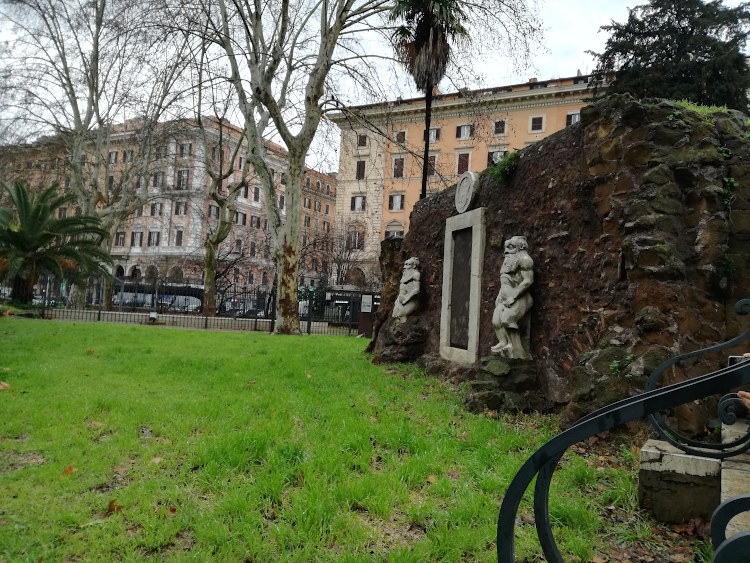
The Alchemical Door
A strange construction can be found inside the Gardens of Piazza Vittorio Emanuele II: above a wall, which nothing supports or separates, are jambs and a lintel of white stone, surmounted by a Carrara marble roundel. However, the portal is walled up, leading nowhere, and the threshold, which cannot be crossed, is guarded by carvings of vigilant dwarves. Dozens of engravings decorate the artifact, esoteric mottos in Latin and arcane symbolism: the Alchemical Door of Rome, a hidden monument, nearly separated from the plane of physical reality in which it stands, gave access to a laboratory where alchemy was practiced.
The present composition of the portal dates from 1888: we know that only then was the squared frame, made of Apennine limestone, placed along a tufa wall. Two statues depicting the Egyptian god Bes were then added, found in the gardens of the Quirinal where a temple dedicated to Serapis once was located. And not coincidentally: Al Kemet, hence the etymon of alchemy, was for the ancient Egyptians the fertile blackish loam that the Nile releases during floods, a symbol of rebirth and transformation. But where was the Alchemical Door originally located? And who made it?
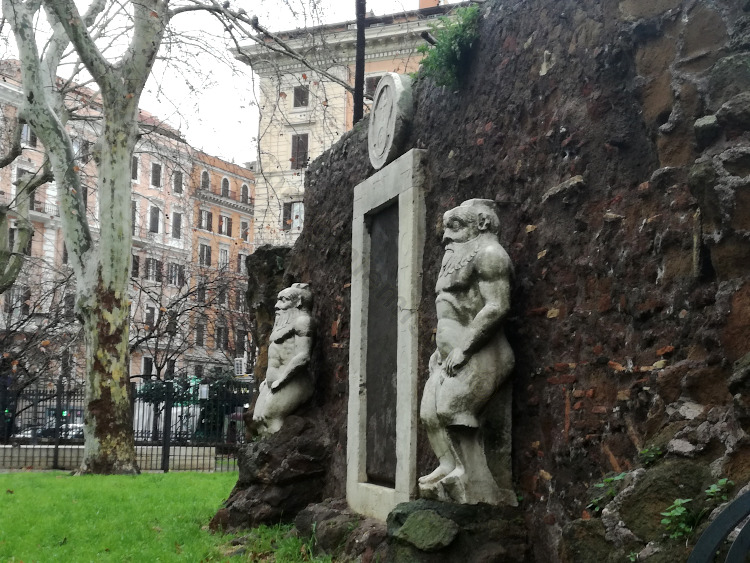
Marquis Massimiliano Savelli Palombara
Initially the artifact was not too far from its present location. The Alchemical Door was located inside the famous “Villa Palombara” on the Esquiline Hill, the property and place of otium of the Marquis of Pietraforte, Massimiliano Savelli Palombara (1614-1685). The nobleman was a lover of occultism: he frequented the Hermetic cenacle that Queen Christina of Sweden had wanted in Rome, and he considered himself heir to the Rosicrucian tradition1. Palombara had inherited the Villa on the Esquiline from his father Oddo V, but had it modified according to ritual, initiatory criteria. For example, he ordered the opening of five doors and had esoteric symbols engraved on each of them.
Marquis Palombara also put his ideas in writing, and in his texts it is possible to trace the same hermetic doctrine that was the inspiration for the Villa. Thus in the Bugia he alluded to the lie and likewise to the object that holds the candle, thus the light that illuminates and unveils the truth2. Villa Palombara was conceived as a grand depiction of the Alchemical Opera, a path of initiation to reach the Philosopher’s Stone. There was indeed a belief that, through alchemical procedures, it was possible to transmute any metal into gold, achieve immortality and attain omniscience, that is, to discern good from evil at all times. Access to the Villa, therefore, was allowed only to those who intended to undertake the initiatory path with a pure heart. Hence laymen, blinded by lust for power and material goods, had to keep their distance.
The mysterious Villa Palombara
Unfortunately, today it is no longer possible to observe Villa Palombara as it was: it was demolished in 1883 to be replaced by neighborhood housing. What we know of it is thanks to Francesco Girolamo Cancellieri (1751-1826), who transcribed the text of the original engravings3 in the Epistolary Dissertations by G. B. Visconti and Filippo Waquier de la Barthe. The author attests how, in the early 19th century, the Door had already been moved to the Villa’s boundary wall, in front of the Church of St. Eusebius. But originally it constituted the entrance to the Marquis’ personal laboratory, a chthonic place where alchemical experiments took place and where important figures of the time connected with occultism, such as Athanasius Kircher and Giuseppe Francesco Borri, used to go. Further, an inscription, placed on an arch, allowed us to place the date of the realization of Palombara’s alchemical project in 16804.
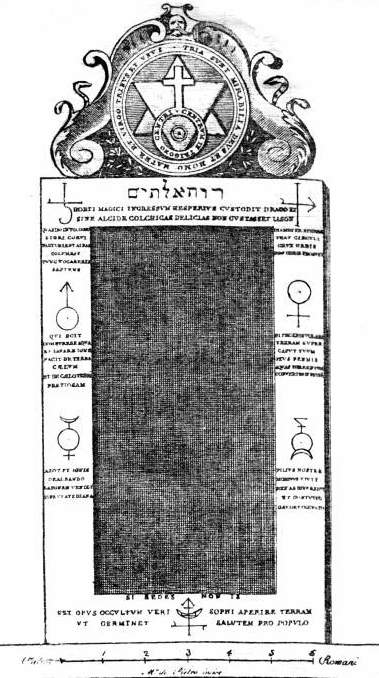
Villa Palombara’s welcome inscription
The Villa’s welcome message placed on one of the boundary walls, which Chancellor faithfully reports in Dissertations5, invited people to be disposed in the right spirit to start the initiatory path:
“In this villa, dew of the sky, from the plowed fields and the flowing waters, the unearthed soil yields its fruit, while by the saltpetre and the sun the smoke of scattered manure rises. This immutable, unchanging forest always retains its appearance, while vines, pear trees and sprightly fruits have sprung up spontaneously. And there is a lake, close to the forest, where not the wolf, but the hare often plays; and does not harm the meek sheep and birds; the guardian dog among the innocent lambs makes the beasts run away, and only the air of this countryside is a means of healing for the sick, and fills the streets of the city with vegetables. The cultivated furrows yield cups of wine”.
“Hoc in Rure, Coeli Rore, fusis Aequis, Physis Aquis, Solum fractum, reddit fructum, dumcum Sale Nitri, Ac Sole, surgunt Fumi sparsi fimi. Istud Nemus, parvus Numus tenet forma sempre firma, dum sunt ortae sine arte Vites, pyra, et Poma pura. Habens Lacum, prope Lucum, ubi Lupus non, sed Lepus saepe ludit; dum non laedit mites Oves, atqua Aves; Canis Custos inter castos agnos Feras mittit foras, et est aegri huius Agri Aer solus vera salus, replens herbis vias Urbis. Sulci sati dant pro siti Scyphos Vini”.
“Come in sincere man”
And again, the inscription continued:
Come in, sincere man. Venus out. To you, thieves, I close the doors. Drink gladly, in profusion, sincere wine, according to the custom of Bacchus. Among the grapes, if you want, rejoice, and take freely all you desire. To thee I prepare, with a sincere heart, whatever thou wilt ask. Here the clear bees provide in abundance sweet honey, always sweet. Hail to you, who weep here in the shadow of the forest. If you read now these signs by standing here summer mixed with spring; never would you weep with mournful forehead, if you stayed among the flowers, nor would you weep with tears, while here the breezes blow, whence melancholy souls hope among the mountains, among the hills, among the paths, and in the valley of this mansion, where a palisade fences the sheep. I wish you well, so may it be forever. But you, as soon as you can, write here, on this door, generated from mud – for stones are born of decay – that time smiles, but in a short time destroys everything”.
“Intro veni, Vir non vanus. Extra Venus. Vobis, Fures claudo Fores Labe lotus, bibas laetus Meri Mare, Bacchi more.Inter Uvas, si vis, ovas, et quod cupis, gratis capis. Tibi paro, corde puro, quicquid putas, a me petas. Dant hic Apes claras opes dulcis mellis. semper mollis. Hic in Sylvae umbra salve Tu,qui luges. Nunc si leges notas istas, stans hic Aestas, vere mista; fronte moesta nunquamfleres, inter flores si maneres, nec manares inter fletus, dum hic platus aure spirant, undesperant mestae mentes inter Montes, inter Colles, inter Calles et in Valle huius Villae, ubi Vallus Claudit Vellus Bonum Omen; sempre Amen. Etiam Petrae dum a putre surgunt Patre, ita notas hic vix natus, in hac Porta, Luto parta, tempus ridet, brevi rodet”.
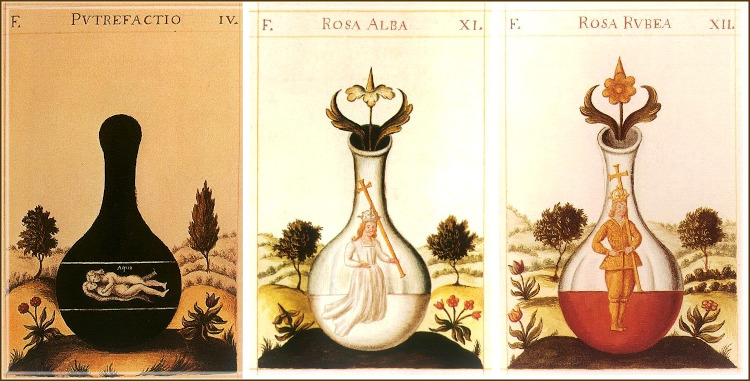
Villa Palombara’s other inscriptions
Here, for the sake of completeness, the text of the other inscriptions that Massimiliano Savelli Palombara had placed in his Villa6 is provided. On the front door, for example, there was the words:
“Passing through the door of this villa, discoverer Jason obtains the fleece of Medea. 1680”.
“Villae ianuam tranando recludens iason obtinet locuples vellus medeae. 1680”.
It is interesting to note the mention of the mythical Jason, the hero who conquers the Golden Fleece during the Argonauts’ enterprise. This analogy recurs often in Marquis Palombara’s literary work and also on the Alchemical Door. For example, in the Bugia, he writes “if you are constant, patient and prudent, according to what a true philosopher must be, you will certainly remain victor with special prerogative among such an infinity of mortals as a new Jason”.
The Golden Fleece is clearly a metaphor for the philosopher’s stone, the only good that the alchemist is called upon to seek over his lifetime. In fact, the initial letters of the phrase engraved on the opening door composed the hermetic acrostic VITRIOLUM, or Visita Interiora Terrae Rectificando Invenies Occultum Lapidem Veram Medicinam, which can be translated as, “Visit the inside of the Earth and working righteously you will find the hidden stone, true medicine”.
With the same gaze, aimed at alchemical research, all the other inscriptions that once decorated Villa Palombara can also be read:
1) “The water from which the gardens are irrigated is not the water from which they are fed.”
“Aqua a qua horti irrigantur non est aqua a qua hort aluntur”.
2) “Stay quiet with just salt and sunshine.”
“Cum solo sale et sole sile.”
3) “The philosopher’s stone is not given to wolves.”
“Sophorum lapis non datur lupis”.
4) “He who reveals the arcana of nature to the powerful desires death.”
“Qui potenti naturae arcana revelat mortem quaerit”.
5) “Today with money you can buy illegitimate nobility, but not legitimate wisdom.”
“Hodie pecunia emitur spuria nobiltas sed non legitima sapientia”.
Marquis Palombara and the legend of successful transmutation
A legend, reported by Cancellieri in Dissertations, tells that a “pilgrim” was hosted at Villa Palombara for one night. He could then walk into the gardens of the residence, since he was searching for a herb needed to produce gold. When the pilgrim left the Villa the next morning, he left behind him a trail of gold straws, a sign that the alchemical transmutation had succeeded! In addition, he handed over to Marquis Palombara some papers, full of enigmas and magical symbols, which contained the secrets of the philosopher’s stone. The marquis then decided to have those signs engraved on the doors of the Villa, as a reminder of what had happened. Pietro Bornia identified the pilgrim with the alchemist Giuseppe Francesco Borri7, but the latter was at that time locked up in a cell since he was condemned by the Holy Roman Inquisition.
The Alchemical Door and the Voynich Manuscript
According to some speculation, the papers that the pilgrim gave to the Marquis were even part of the Voynich manuscript, a 15th-century illustrated codex known for the oddity of its contents and still indecipherable today. The volume consists of four sections in two hundred and four pages, which contain depictions of botany, astronomy, biology, and pharmacology. Most importantly, they are written in an incomprehensible, possibly encrypted language. Moreover, there are pictures of unknown plants and vegetables, of creepy humanoids without clothes. One can well understand the fame of the Voynich manuscript, which is rightly considered the “most mysterious book in the World,” as Medieval philosophy professor Robert Brumbaugh defined it8.
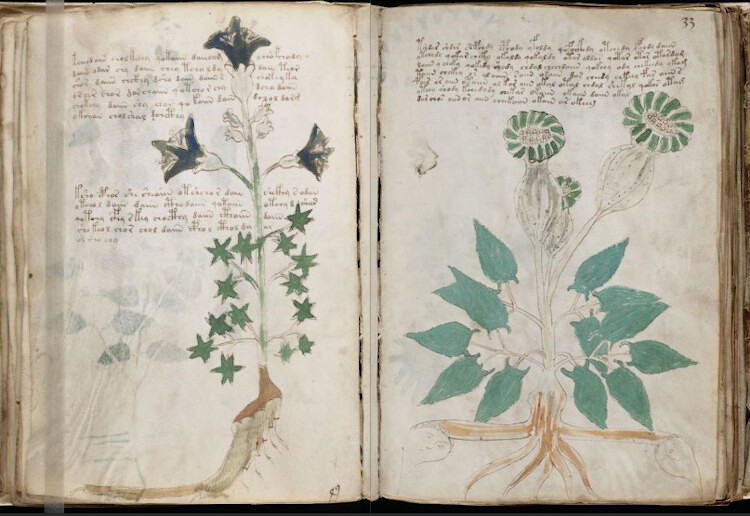
The origins of the Voynich manuscript and Athanasius Kircher
The manuscript was named by Wilfrid Voynich, who found it in the Jesuit college of Villa Mondragone in Frascati. Inside the volume was discovered a letter from the rector of the University of Prague, Johannes Marcus Marci, addressed to his friend Athanasius Kircher. The academic had sent the manuscript to Kircher hoping that he could decipher it. In fact, he was famous as an expert in esotericism and the alchemical sciences. Not coincidentally, Kircher himself was the master of the alchemist Giuseppe Francesco Borri, the man whom legend links to the Alchemical Door of Rome.
Is it possible, then, that Athanasius Kircher had bequeathed the precious Voynich manuscript to his most trusted disciple Francesco Borri? What secrets does the indecipherable volume contain? Secrets, perhaps, that would have allowed Borri to transmute the base metal into gold.
The symbolism of the Alchemical Door
The symbols engraved on the remaining door of Villa Palombara belong to the rich esoteric tradition of the 17th century, of which we have historiographical evidence. A Solomon seal is thus circumscribed within a lithic disk, which surmounts the portal lintel and carries the motto:
“Tria sunt mirabilia deus et homo mater et virgo trinus et unus”.
“The three are admirable: God and man, the mother and the Virgin, trinity and unity”.
Translation by Francesco Roesler Franz, The Roesler Franz Family and the Initiatic Path, Youcanprint 2022
This is a reference to the principles of the Alchemical Work, namely spirit, soul and body, to which the three main stages of the transmutation process refer: nigredo, albedo, rubedo.
The six-pointed star of the seal is intersected by a solar depiction at the bottom, an alchemical oculus symbolizing gold, and from which departs a cross pointing skyward. Along the circumference of the oculus can be read:
“Centrum in trigoni centri”.
“The centre is in the triangle of the centre”.
Translation by Francesco Roesler Franz, The Roesler Franz Family and the Initiatic Path, Youcanprint 2022
Marquis Palombara certainly had to find this symbology from the texts of the German alchemist Adrian von Mynsicht (1603-1638), who had published the Rosicrucian treatise Aureum Seculum Redivivum under the pseudonym Henricus Madatanus9. Well, on the title page, in a posthumous printing of 1677, was drawn the hexagram later reproduced in the Alchemical Door.
The portal frame contains a vast allegory of alchemical symbols, certainly taken from Johannes de Monte-Snyder’s Chymica vannus – Commentatio de pharmaco catholico (1655)10. Specifically, there are seven signs of planets paired with corresponding metals: Saturn-lead; Jupiter-tin; Mars-iron; Venus-copper; Mercury-mercury; Sun-gold; Moon-silver. Each symbol is associated with a short hermetic motto that indicated the operations to be carried out during the alchemical process. The signs should therefore be read according to a boustrophedon pattern.
The mottos on the jambs of the Alchemical Door
Thus for Saturn the Alchemical Door reveals:
“When in your house the black crows will generate white doves, you will be called wise”.
“Quando in tua domo nigri corvi parturient albas columbas tunic vocaberis sapiens”.
Translation by Francesco Roesler Franz, The Roesler Franz Family and the Initiatic Path, Youcanprint 2022
This is a reference to nigredo, the first phase of the Alchemical Work. Of Jupiter, on the other hand, it is said:
“The diameter of the sphere, the tau of the circle, the cross of the globe are of no use to the blind”.
“Diameter spherae thau circuli crux orbis non orbis prosunt”.
Translation by Francesco Roesler Franz, The Roesler Franz Family and the Initiatic Path, Youcanprint 2022
Epigraph in which reference is made to saltpeter, the diameter of the sphere, to Vitriolum, here tau of the circle, and finally to antimony, that is, the cross of the globe. To undertake the alchemical path one cannot be blind. One needs to possess the knowledge symbolized by Jupiter. o Mars the Alchemical Door associates the inscription:
“He who knows how to burn with water and to wash with fire will transform the earth into heaven and and heaven into precious earth”.
“Qui scit comburere aqua et lavare igne facit de terra caelum et de caelo terram pretiosam”.
Translation by Francesco Roesler Franz, The Roesler Franz Family and the Initiatic Path, Youcanprint 2022
How can we burn with water and wash with fire? This paradox should be read in allegorical terms: the soul of man had to be as clear as water and as light as the sky. This is possible only by passing through the purifying flame of spiritual fire. In practical terms this translated into the material union of sulfur and mercury. Also referring to this process of elevation of the soul is the inscription associated with Venus:
“He who makes the earth fly with the breath of his own head, will have converted the water of the torrents into stone”.
“Si feceris volare terram super caput tuum eius pennis aquas torrentium convertes in petram”.
Translation by Francesco Roesler Franz, The Roesler Franz Family and the Initiatic Path, Youcanprint 2022
It is thus said about Mercury:
“Nitrogen and Fire: bleaching Leto, will come Diana without a robe”.
“Azot et Ignis dealbando latonam veniet sine veste diana”.
Leto was the goddess of progress and transformation; Diana is to be regarded here as the image of light, as the etymology from the Proto-Indo-European dyeu, meaning “bright.” The figure of resurrection is invoked for the sun, which sets each evening and then returns in the morning:
“Our dead son lives and will return as king of the world, of fire and beneficiary of the occult marriage”.
“Filius noster mortuus vivit rex ab igne redit et coniugio gaudet occulto”.
Translation by Francesco Roesler Franz, The Roesler Franz Family and the Initiatic Path, Youcanprint 2022
Hence, the alchemist is called to be reborn as a new man and to experience the fullness of knowledge.
The threshold of the Alchemical Door
On the threshold, the Alchemical Door exhorts the one who has found the philosopher’s stone to put that knowledge at the service of all, not to keep it only for himself:
“The secret task of the wise man is to open the earth to bring salvation to the people”.
“Est opus occultum veri sophi aperire terram ut germinet salutem pro populo”.
Translation by Francesco Roesler Franz, The Roesler Franz Family and the Initiatic Path, Youcanprint 2022
Above all, there is here the palindromic motto that most urges one to persevere in the alchemical quest::
“If you sit you don’t go” or “If you don’t sit you go” by inverting the direction of reading.
“Si sedes non is”.
The Divine Spirit
All nature and the Universe obey the Spirit of God, here evoked in the lintel through the Hebrew wording רוח אלהים, Ruach Elohim. The Alchemical Door thus represents the threshold that man must cross to reach divine illumination, the spiritual gnosis that can elevate him to a higher stage of knowledge, not without effort.
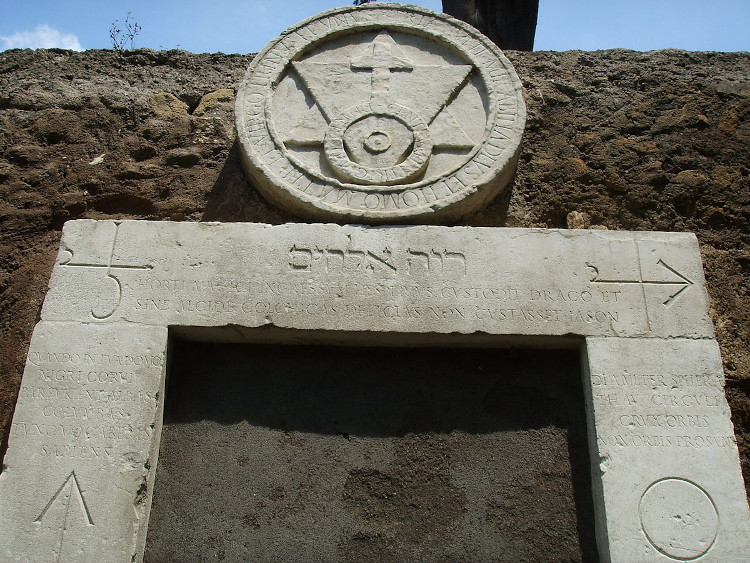
This concept is recalled again by means of the figure of Jason, who in the myth has to put a dragon to sleep in order to reach the Golden Fleece:
“The dragon guards the entrance to the magical garden, and without Hercules Jason would not have been able to taste the delights of Colchis”.
“Horti magici ingressum Hesperius custodit draco et sine Alcide colchicas delicias non gustasset Iason” .
Translation by Francesco Roesler Franz, The Roesler Franz Family and the Initiatic Path, Youcanprint 2022
The philosopher’s stone as man’s inner path
The Alchemical Door of Rome, as is evident from the symbolism and epigraphs engraved on it, is an allegory of the “solve et coagula” principle, so dear to 17th-century Hermetists. Such was the foundational logos of man’s spiritual transformation, made explicit through the transitions between the different phases of matter (lead, silver, mercury etc.). “Dissolve and reunite”: transmuting lead into the noblest gold meant dissolving the old man in order to access the true essence of self, a difficult path reserved only for the initiated (It is the occult work of the wise person) and not suitable for the profane ([…] the cross of the globe are of no use to the blind).
The Alchemical Door thus depicted the threshold that the initiate had to cross to access the path; it was a metaphor for the inner will that drove him or her to perfection (If you sit you do not go). This inner transmutation took place through the solving of the most elemental matter (also called salt) and, as impurities were removed, ended with the attainment of the highest stage of purity, the Philosopher’s Stone. This was the stage of the deepest knowledge, of the one who died, lives, returns king from the fire and enjoys occult marriage.
Samuele Corrente Naso, translation by Daniela Campus
Map of places
Notes
- M. F. Iovine, Massimiliano Palombara filosofo incognito. Appunti per una biografia di un alchimista rosacrociano del XVII secolo, La Lepre Edizioni, 2016. ↩︎
- M. Savelli Palombara, La Bugia. Rime del Marchese Massimiliano Palombara, MDCLX; nel Codice Reginense Lat. 1521 conservato nella Biblioteca Apostolica Vaticana. ↩︎
- F. Cancellieri, E. Q. Visconti, Dissertazioni epistolari di G. B. Visconti e Filippo Waquier de la Barthe sopra la statua del discobolo scoperta nella Villa Palombara, Fulgoni, 1806. ↩︎
- Cesare Lucarini, La porta magica di Roma: Le epigrafi svelate, Edizioni Nuova Cultura, 2017. ↩︎
- P. Bornia, La Porta Magica di Roma, Studio storico, Luce e Ombra, 1915. ↩︎
- Ibidem note 3. ↩︎
- Ibidem note 5. ↩︎
- R. Brumbaugh, The World’s Most Mysterious Manuscript, Londra, Weidenfeld & Nicolson, 1977. ↩︎
- Ibidem note 4. ↩︎
- Iohnannes de Monte-Snyder, Chymica vannus-Commentatio de pharmaco catholico, Amsterdam, Apud Joannem Janssonium à Waesberge & Elizeum Weyerstraet, 1666. ↩︎
- Foto di Sailko – Opera propria, CC BY 2.5., image. ↩︎

